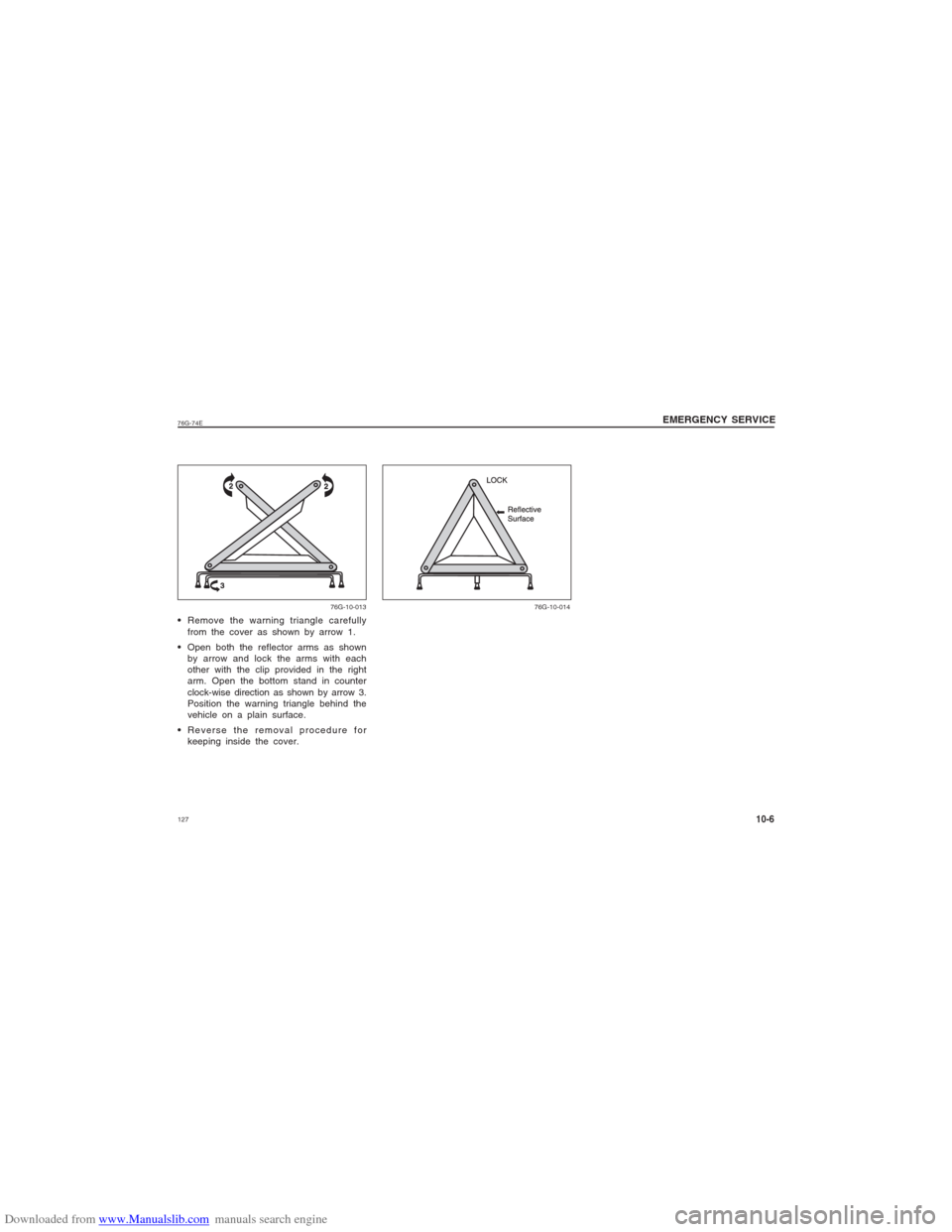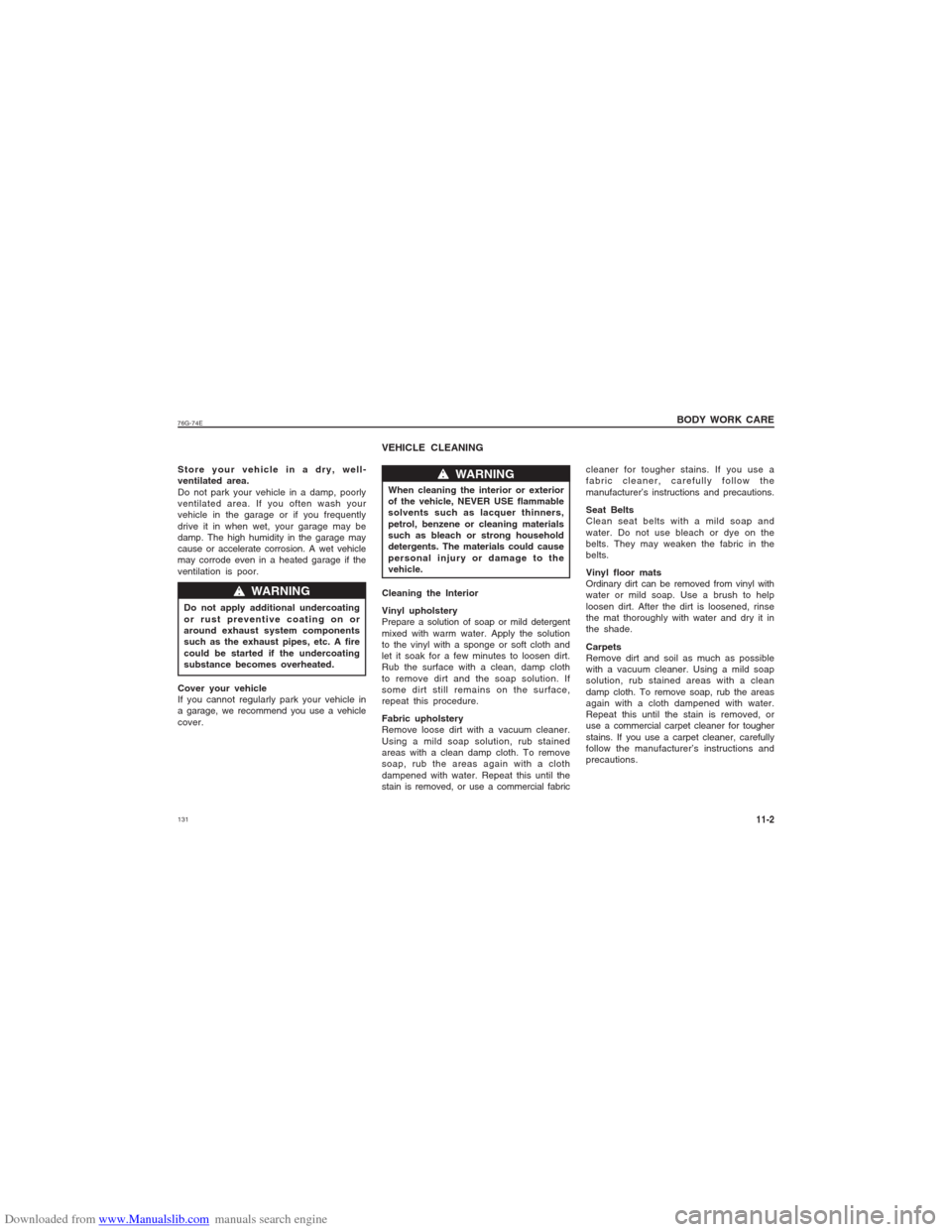2007 SUZUKI ALTO Car ac
[x] Cancel search: Car acPage 126 of 139

Downloaded from www.Manualslib.com manuals search engine 12776G-74ERemove the warning triangle carefully
from the cover as shown by arrow 1.
Open both the reflector arms as shown
by arrow and lock the arms with each
other with the clip provided in the right
arm. Open the bottom stand in counter
clock-wise direction as shown by arrow 3.
Position the warning triangle behind the
vehicle on a plain surface.
Reverse the removal procedure for
keeping inside the cover.
EMERGENCY SERVICE
10-6
76G-10-013 76G-10-014
Page 128 of 139

Downloaded from www.Manualslib.com manuals search engine 12976G-74E
BODY WORK CARE
11
BODY WORK CARE
Corrosion Prevention.......................................................................................11-1
Vehicle Cleaning...............................................................................................11-2
Page 129 of 139

Downloaded from www.Manualslib.com manuals search engine 130
76G-74E
CORROSION PREVENTION
the vehicle which are not well ventilated
to permit quick drying.
This information illustrates the necessity of
keeping your vehicle (particularly the
underbody) as clean and dry as possible.
It is equally important to repair any damage
to the paint or protective coatings as soon
as possible.
How to Help Prevent Corrosion
Wash your vehicle frequently
The best way to preserve the finish on your
vehicle and to help avoid corrosion is to
keep it clean with frequent washing.
Wash your vehicle regularly during the
winter and immediately after the winter.
Keep your vehicle, particularly the
underside, as clean and dry as possible.
If you frequently drive on salted roads, your
vehicle should be washed at least once a
month during the winter. If you live near the
ocean, your vehicle should be washed at
least once a month throughout the year.
For washing instructions, refer to the
“VEHICLE CLEANING” section.
Remove foreign material deposits
Foreign material such as salts, chemicals,
road oil or tar, tree sap, bird droppings and
industrial fall-out may damage the finish of
your vehicle if it is left on painted surfaces.
Remove these types of deposits as quicklyas possible. If these deposits are difficult to
wash off, an additional cleaner may be
required. Be sure that any cleaner you use
is not harmful to painted surfaces and is
specifically intended for your purposes.
Follow the manufacturer’s directions when
using these special cleaners.
Repair finish damage
Carefully examine your vehicle for damage
to the painted surfaces. Should you find any
chips or scratches in the paint, touch them
up immediately to prevent corrosion from
starting. If the chips or scratches have gone
through to the bare metal, have a qualified
body shop make the repair.
Keep Passenger and luggage
compartments clean.
Moisture, dirt or mud can accumulate under
the floor mats and may cause corrosion.
Occasionally, check under these mats to
ensure that this area is clean and dry. More
frequent checks are necessary if the vehicle
is used off road or in wet weather.
Certain cargos such as chemicals, fertilizers,
cleaners, salts, etc., are extremely corrosive
by nature. These products should be
transported in sealed containers. If a spill
or leak does occur, clean and dry the area
immediately. It is important to take good care of your
vehicle to protect it from corrosion.
Listed below are instructions for how to
maintain your vehicle to prevent corrosion.
Please read and follow these instructions
carefully.
Important Information About Corrosion
Common causes of corrosion
1) Accumulation of road salt, dirt, moisture,
or chemicals in hard to reach areas of
the vehicle underbody or frame.
2) Chipping, scratches and any damage to
treated or painted metal surfaces
resulting from minor accidents or
abrasion by stones and gravel.
Environmental conditions which
accelerate corrosion
1) Road salt, dust control chemicals, sea
air or industrial pollution will all
accelerate the corrosion of metal.
2) High humidity will increase the rate of
corrosion particularly when the
temperature range is just above the
freezing point.
3) Moisture in certain areas of a vehicle for
an extended period of time may promote
corrosion even though other body
sections may be completely dry.
4) High temperatures will cause an
accelerated rate of corrosion to parts of
BODY WORK CARE11-1
Page 130 of 139

Downloaded from www.Manualslib.com manuals search engine 13176G-74EStore your vehicle in a dry, well-
ventilated area.
Do not park your vehicle in a damp, poorly
ventilated area. If you often wash your
vehicle in the garage or if you frequently
drive it in when wet, your garage may be
damp. The high humidity in the garage may
cause or accelerate corrosion. A wet vehicle
may corrode even in a heated garage if the
ventilation is poor.
Do not apply additional undercoating
or rust preventive coating on or
around exhaust system components
such as the exhaust pipes, etc. A fire
could be started if the undercoating
substance becomes overheated.
Cover your vehicle
If you cannot regularly park your vehicle in
a garage, we recommend you use a vehicle
cover.
VEHICLE CLEANING
cleaner for tougher stains. If you use a
fabric cleaner, carefully follow the
manufacturer’s instructions and precautions.
Seat Belts
Clean seat belts with a mild soap and
water. Do not use bleach or dye on the
belts. They may weaken the fabric in the
belts.
Vinyl floor mats
Ordinary dirt can be removed from vinyl with
water or mild soap. Use a brush to help
loosen dirt. After the dirt is loosened, rinse
the mat thoroughly with water and dry it in
the shade.
Carpets
Remove dirt and soil as much as possible
with a vacuum cleaner. Using a mild soap
solution, rub stained areas with a clean
damp cloth. To remove soap, rub the areas
again with a cloth dampened with water.
Repeat this until the stain is removed, or
use a commercial carpet cleaner for tougher
stains. If you use a carpet cleaner, carefully
follow the manufacturer’s instructions and
precautions.
w ww w
w WARNING
When cleaning the interior or exterior
of the vehicle, NEVER USE flammable
solvents such as lacquer thinners,
petrol, benzene or cleaning materials
such as bleach or strong household
detergents. The materials could cause
personal injury or damage to the
vehicle.
Cleaning the Interior
Vinyl upholstery
Prepare a solution of soap or mild detergent
mixed with warm water. Apply the solution
to the vinyl with a sponge or soft cloth and
let it soak for a few minutes to loosen dirt.
Rub the surface with a clean, damp cloth
to remove dirt and the soap solution. If
some dirt still remains on the surface,
repeat this procedure.
Fabric upholstery
Remove loose dirt with a vacuum cleaner.
Using a mild soap solution, rub stained
areas with a clean damp cloth. To remove
soap, rub the areas again with a cloth
dampened with water. Repeat this until the
stain is removed, or use a commercial fabric
w ww w
w WARNING
BODY WORK CARE
11-2
Page 131 of 139

Downloaded from www.Manualslib.com manuals search engine 132
76G-74E
Cleaning the Exterior
It is important that your vehicle be
kept clean and free from dirt. Failure
to keep your vehicle clean may result
in fading of the paint or corrosion to
various parts of the vehicle body.
Washing
Never attempt to wash and wax your
vehicle with the engine running.
When cleaning the underside of the
body and fender, where there may
be sharp-edged parts, you should
wear gloves and a longsleeved shirt
to protect your hands and arms
from being cut.
After washing your vehicle, carefully
test the brakes before driving to
make sure they have maintained
their normal effectiveness.When washing the vehicle, follow the
instructions below:
1) Flush the underside of body and wheel
housings with pressurized water to
remove mud and debris. Use plenty of
water.
When washing the vehicle, avoid
directing steam or hot water of more
than 80
0C (176
0F) on plastic parts.
2) Remove dirt and mud from the body
exterior with running water. You may use
a soft sponge or brush. Do not use hard
materials which can scratch the paint.
3) Wash the entire exterior with a mild
detergent or car wash soap using a
sponge or soft cloth. The sponge or
cloth should be frequently soaked in the
soap solution.
When using a commercial car wash
product, observe the cautions
specified by the manufacturer. Never
use strong household detergents or
soaps.
BODY WORK CARE11-3
w ww w
w WARNING
CAUTION
4) Once the dirt has been completely
removed, rinse off the detergent with
running water.
5) After rinsing, wipe off the vehicle body
with a wet chamois or cloth and allow
it to dry in the shade.
6) Check carefully for damage to painted
surfaces. If there is any damage,
“Touchup” the damage following the
procedure below:
a) Clean all damaged spots and allow
them to dry.
b) Stir the paint and “touchup” the
damaged spots lightly using a small
brush.
c) Allow the paint to dry completely.
Waxing
After washing the vehicle, waxing and
polishing are recommended to further
protect and beautify the paint.
Only use waxes and polishes of good
quality.
When using waxes and polishes,
observe the precautions specified by the
manufacturers.
CAUTION
CAUTION